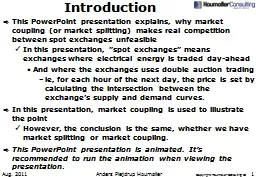

This PowerPoint presentation explains why market coupling or market splitting makes real competition between spot exchanges unfeasible In this presentation spot exchanges means exchanges where electrical energy is traded dayahead ID: 431887
Download Presentation The PPT/PDF document "Introduction" is the property of its rightful owner. Permission is granted to download and print the materials on this web site for personal, non-commercial use only, and to display it on your personal computer provided you do not modify the materials and that you retain all copyright notices contained in the materials. By downloading content from our website, you accept the terms of this agreement.
Slide1
Introduction
This PowerPoint presentation explains, why market coupling (or market splitting) makes real competition between spot exchanges unfeasibleIn this presentation, ”spot exchanges” means exchanges where electrical energy is traded day-aheadAnd where the exchanges uses double auction tradingie, for each hour of the next day, the price is set by calculating the intersection between the exchange’s supply and demand curves.In this presentation, market coupling is used to illustrate the pointHowever, the conclusion is the same, whether we have market splitting or market coupling.This PowerPoint presentation is animated. It’s recommended to run the animation when viewing the presentation.
Aug. 2011
Anders Plejdrup Houmøller
1Slide2
Example – 1
For a given country, assume we have 5 competing spot exchanges – all participating in market coupling.The market coupling will run the following way:Shortly after gate closure, the five exchanges send their day-ahead bids to the market coupling company (MCC).For each hour of the following day, MCC calculates the country’s electricity price. The MCC calculation is based on:All the country’s day-ahead bids (the bids from the 5 exchanges).The capacities on the links to neighbouring countriesAnd the day-ahead bids in these countries.
Aug. 2011
Anders Plejdrup Houmøller
2Slide3
Example – 2
We are considering one given hour of the next dayFor simplicity, assume for this hour the market coupling creates zero net energy flow to/from the neighbouring countriesie., the total sales of energy to the country’s spot exchanges is equal to the total purchase of energy from the country’s spot exchanges – even when the market coupling is taken into account.Assume MCC calculates a price 40 EUR/MWh for this hour.Problem: at the price 40 EUR/MWh, each of the 5 exchanges will normally not have a sale, which is equal to the purchaseFor example: an exchange can not pay (all) the sellers, if the sale to the exchange is 500 MWh higher than the purchase from the exchange.
Hence, the exchanges can not do the settlement (also called the clearing)!
Aug. 2011
Anders Plejdrup Houmøller
3Slide4
Example – 3
Conclusion: behind the 5 exchanges, there must be a common clearing house.However, now the pretended competition between the five exchanges is just a cost-increasing smokescreenBehind the 5 exchanges, you find the monopolist: the common clearing house.Aug. 2011Anders Plejdrup Houmøller
4Slide5
Country
Example – 4One hour of the next day.The market coupling does not create net inflow/outflow of energy
5
P: Players
Link
A
: 1000 MWh energy inflow from market coupling
PX: Power
exchange
I: Imbalance be-
tween the sale to
the exchange and
the purchase
from the exchange
Link
B
: 1000 MWh
energy
outflow from
market coupling
PX
1
P
Clearing
house
Sell
Buy
PX
2
P
Sell
Buy
PX
5
I
3
I
4
I
5
PX
3
PX
4
P
P
P
Sell
Buy
Sell
Buy
Sell
Buy
I
1
I
2Slide6
Conclusion from the example – 1
The clearing house may be replaced by a network of payments between the 5 exchangesHowever, this is a very complicated and costly solution; and the payment network now assumes the monopoly role of the clearing house.With the liquidity from the market coupling somehow granted to the ”commercial” exchanges?Conclusion – with market coupling as the day-ahead congestion management system:The fair and cost-efficient solution is one, regulated spot exchange per country (or per region)This exchange must be regulated as a monopoly, as a competing spot exchange does not exist.
Note: it’s the clearing (ie, the settlement), which makes the competition unfeasible
.
Aug. 2011
6Slide7
Conclusion from the example – 2
The market coupling company carries out the price calculation.Hence, the local exchange becomes a clearing houseCarrying out the settlement of the day-ahead exchange trading of electrical energy.In a later step, the settlement can be centralisedMaking it possible for the players to net their day-ahead positions over a large geographical area.And eliminating the need for the market coupling company and other cross-border traders to post big, redundant collaterals towards different clearing houses in different countries.Then, the local offices become sales offices for this common day-ahead exchange trading system.
Aug. 2011
7Slide8
Thank you for your attention!
8Anders Plejdrup Houmøller
Houmoller ConsultingTel. +45 28 11 23 00
anders@houmollerconsulting.dk